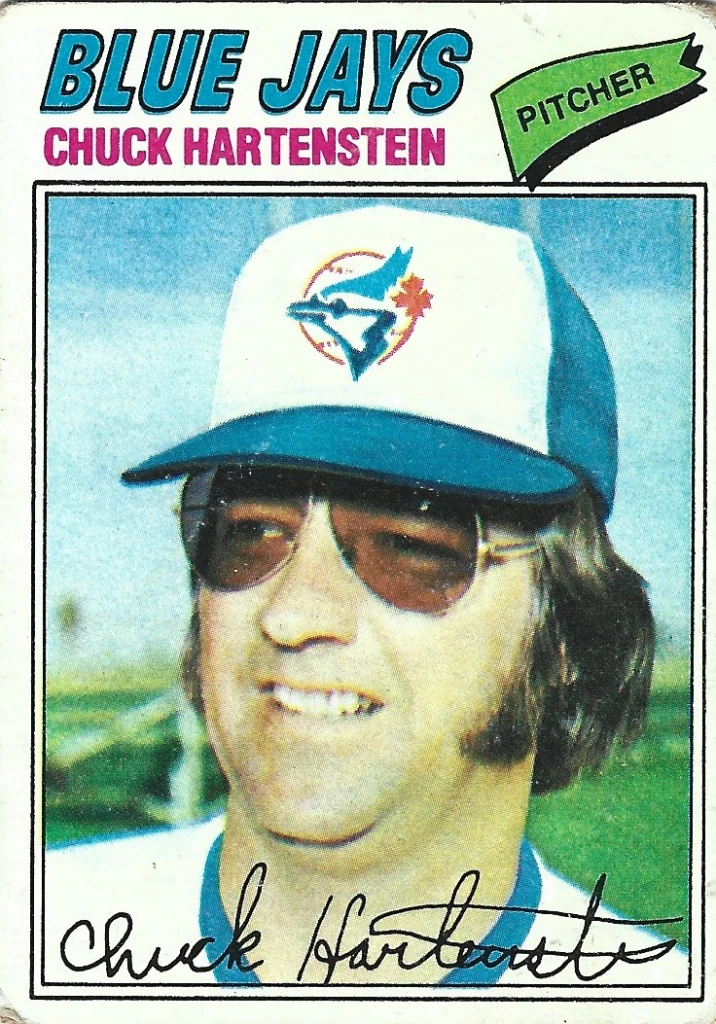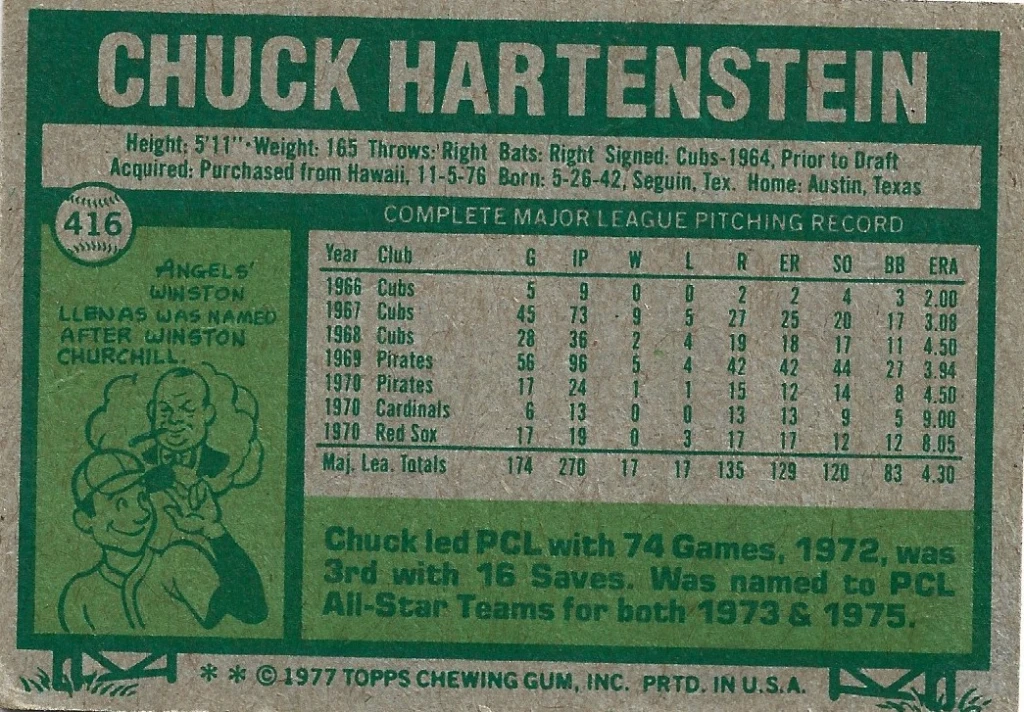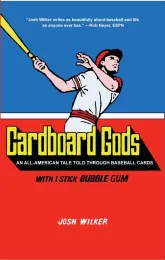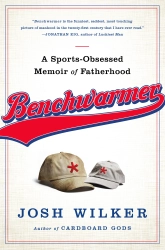
Chuck Hartenstein
August 29, 2023This card is a miracle. Mundane, unsinkable life triumphs over blurred dissolution. A man, despite the befogged oblivion behind him, despite the intrusion of transient, haphazard artificiality in his airbrushed cap and uniform, hasn’t dissolved into the cartoony murk closing in all around him. He is here. He resists disappearance with the homely, inarguable details of his life, tinted aviator glasses, muttonchops, the hinting of a double chin, an expression somewhere between a grimace and a smile, the countenance of a man who’s worked, who’s suffered fools, who’ll live and let live, who’s not going anywhere, not yet: Chuck Hartenstein.
That name! A one-two punch of the one-syllable prosaic and three-syllable clunky, mirroring in that way the greatest of all journeymen, Joe Shlabotnik, the man here a real-life corollary to Charlie Brown’s idol, way out on the margins, almost a complete nobody, yet still tethered to this world, beloved.
The back of the card (shown below) is even better: uncanny, unbelievable. The card appeared in 1977, a full seven years after the last year listed in the statistics. And that last year, split across short, crumbling stints with three teams, seemed to tell the tale of someone losing it completely: first a mediocre 17 games with the Pirates, where he compiled a 4.50 ERA, then 6 disastrous games for the Cardinals resulting in a 9.00 ERA, and finally an 8.05 ERA in 17 games for the Red Sox. And these numbers, so far in the past, are reinforced in their intimations of baseball doom by Chuck Hartenstein’s age: 34 at the start of the 1977 season, soon to be 35. Where had he been from 1970 to 1977? There’s some mention of minor league accomplishments in the text filling space where Chuck Hartenstein’s major league numbers leave off, but even the last year mentioned in that text was already two years in the past. Even the transactions section of the card suggests inconsequentiality. Chuck Hartenstein was acquired by the Blue Jays on the day of the 1976 expansion draft, but he didn’t come to them via that draft but was instead purchased by the new team, an afterthought, an extra body.
But he’s made it back. I don’t know how Topps worked with the two expansion teams that year to determine the players who would be in the first Topps sets for the Blue Jays and Mariners, but there must have been some certainty on the part of Toronto that the inaugural season for the franchise would include Chuck Hartenstein. And in fact he did officially return to the major leagues that year, seven years after his last appearance, one of the longest gaps ever between major league appearances. (The longest is utterly incredible and, compared with Chuck Hartenstein’s dogged accomplishment, a fluke—22 years, by Paul Schrieber, who after pitching briefly as a 19- and 20-year-old in the 1920s served as a batting practice pitcher for the 1945 Yankees and was pressed into duty for two games because so many younger players were in the armed services.) It didn’t go so well for Chuck Hartenstein in 1977, as evidenced by his 6.59 ERA, but that’s beside the point: he not only made it all the way back, the center of a miracle, he made it back with style, becoming enough of a presence in the world that had shunned him for the better part of a decade to earn an alias worthy to stand among all the other beauties—Blue Moon, Charlie Hustle, Spaceman, etc.—in a roll call from that last great era of baseball nicknames: Olde Frankenstein.
He gives me hope, Olde Frankenstein, Chuck Hartenstein. You get older, you start thinking that you’ve seen the last of a lot of things. For example, on my worried mind, always, is my writing, and it’s now been eight years since I published a book, longer than the time between Chuck Hartenstein’s last major league appearance and the appearance of this card. But the message of this wondrous card is that you keep going, you keep trying. Wherever you are, scuffling around in the bush leagues, in a world of blur and make-believe, in a slow deterioration of ever-thickening corrective lenses, doubling chins, muttonchops, grimaces, you’re alive, a miracle, and can try.







Now I’m really curious about the career of Winston Llenas. Off to BRef.
I’m getting some major George Jones vibes. ‘Ol Chuck looks like he pounded a brewski or 3 in the bush leagues which doesn’t sound too bad in those idyllic 1970’s muff-chasing years.
The 1977 set had the highest percentage of airbrushed cards out of any set ever. Not including Traded sets of course. The John D’Acquisto card may be the all time champ of airbrushing.
But getting back to the subject card, Topps looked like they really hustled to get the Jays/Mariners cards ready between early November and Spring Training when the cards hit stores, judging by how and when Hartenstein was acquired as shown on the card back. And good for Topps, and for Chuck, as ’77 was his last season.
A Joe Shlabotnik reference? My personal hero.
hahaha. I had this card and NEVER looked at it closely or flipped it over. It was so drab.
Now i love it.
How cool is it he had not been in majors for 7 years!
I love the elder comeback.
I would have been at every game he pitched if i could : )
Love the Winston Lleanas reference to winston churhill on back!
This whole post had astonishing facts, including that it has been eight years since your last book. Hope this is foreshadowing.
Chuck Hartenstein has left the building. He died in 2021 at the age of 79. Thanks for the post and the inspiration.
to all the new CH fans, here is link to radio broadcast of a game he pitched in 1977!!
i was falling asleep to the game (we have all gone to sleep listening to games, admit it) when i though it was dreaming of chuck…however it was really chuck entering the game!! 1977 04 15 Blue Jays at White Sox Classic Baseball Radio